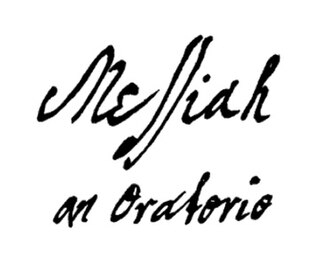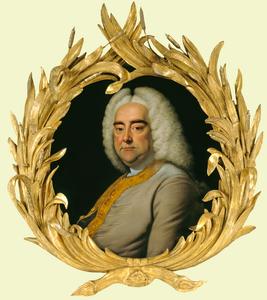
George FridericHandel was a German-British Baroque composer well known for his operas, oratorios, anthems, concerti grossi, and organ concertos. Handel received his training in Halle and worked as a composer in Hamburg and Italy before settling in London in 1712, where he spent the bulk of his career and became a naturalised British subject in 1727. He was strongly influenced both by the middle-German polyphonic choral tradition and by composers of the Italian Baroque. In turn, Handel's music forms one of the peaks of the "high baroque" style, bringing Italian opera to its highest development, creating the genres of English oratorio and organ concerto, and introducing a new style into English church music. He is consistently recognized as one of the greatest composers of his age.

Messiah is an English-language oratorio composed in 1741 by George Frideric Handel. The text was compiled from the King James Bible and the Coverdale Psalter by Charles Jennens. It was first performed in Dublin on 13 April 1742 and received its London premiere a year later. After an initially modest public reception, the oratorio gained in popularity, eventually becoming one of the best-known and most frequently performed choral works in Western music.

Agrippina is an opera seria in three acts by George Frideric Handel with a libretto by Cardinal Vincenzo Grimani. Composed for the 1709–10 Venice Carnevale season, the opera tells the story of Agrippina, the mother of Nero, as she plots the downfall of the Roman Emperor Claudius and the installation of her son as emperor. Grimani's libretto, considered one of the best that Handel set, is an "anti-heroic satirical comedy", full of topical political allusions. Some analysts believe that it reflects Grimani's political and diplomatic rivalry with Pope Clement XI.

Saul is a dramatic oratorio in three acts written by George Frideric Handel with a libretto by Charles Jennens. Taken from the First Book of Samuel, the story of Saul focuses on the first king of Israel's relationship with his eventual successor, David—one which turns from admiration to envy and hatred, ultimately leading to the downfall of the eponymous monarch. The work, which Handel composed in 1738, includes the famous "Dead March", a funeral anthem for Saul and his son Jonathan following their deaths in the Battle of Mount Gilboa at the hands of the Philistines, and some of the composer's most dramatic choral pieces. Saul was first performed at the King's Theatre in London on 16 January 1739. The work was a success at its London premiere and was revived by Handel in subsequent seasons. Notable modern-day performances of Saul include that at Glyndebourne in 2015.

Solomon, HWV 67, is an oratorio by George Frideric Handel. The anonymous libretto – currently thought to have been penned by the English Jewish poet/playwright Moses Mendes (d.1758) – is based on the biblical stories of the wise king Solomon from the First Book of Kings and the Second Book of Chronicles, with additional material from Antiquities of the Jews by ancient historian Flavius Josephus. The music was composed between 5 May and 13 June 1748, and the first performance took place on 17 March 1749, with Caterina Galli in the title role at the Covent Garden Theatre in London, where it had two further performances. Handel revived the work in 1759.

La resurrezione, HWV 47, is an oratorio by George Frideric Handel, set to a libretto by Carlo Sigismondo Capece (1652–1728). Capece was court poet to Queen Marie Casimire of Poland, who was living in exile in Rome. It was first performed on Easter Sunday, 8 April 1708 at Rome, with the backing of the Marchese Francesco Ruspoli, Handel's patron at this time. The work details the events between — and during — Good Friday and Easter Sunday, with the action carried forward in recitative, and exploration of character and delineation of mood taking place in the arias. The characters of the liturgical drama that appear in the oratorio are Lucifer (bass), Mary Magdalene (soprano), an angel (soprano), John the Evangelist (tenor), and Mary Cleophas (alto).

The Handel organ concertos, Op. 4, HWV 289–294, are six organ concertos for chamber organ and orchestra composed by George Frideric Handel in London between 1735 and 1736 and published in 1738 by the printing company of John Walsh. Written as interludes in performances of oratorios in Covent Garden, they were the first works of their kind for this combination of instruments and served as a model for later composers.

The Handel organ concertos, Op. 7, HWV 306–311, refer to the six organ concertos for organ and orchestra composed by George Frideric Handel in London between 1740 and 1751, published posthumously in 1761 by the printing company of John Walsh. They were written for performance during Handel's oratorios, contain almost entirely original material, including some of his most popular and inspired movements.
A fine and delicate touch, a volant finger, and a ready delivery of passages the most difficult, are the praise of inferior artists: they were not noticed in Handel, whose excellencies were of a far superior kind; and his amazing command of the instrument, the fullness of his harmony, the grandeur and dignity of his style, the copiousness of his imagination, and the fertility of his invention were qualities that absorbed every inferior attainment. When he gave a concerto, his method in general was to introduce it with a voluntary movement on the diapasons, which stole on the ear in a slow and solemn progression; the harmony close wrought, and as full as could possibly be expressed; the passages concatenated with stupendous art, the whole at the same time being perfectly intelligible, and carrying the appearance of great simplicity. This kind of prelude was succeeded by the concerto itself, which he executed with a degree of spirit and firmness that no one ever pretended to equal.

Un'alma innamorata is a dramatic secular cantata for soprano and instruments written by George Frideric Handel in 1707. Other catalogues of Handel's music have referred to the work as HG liiB,92; and HHA v/5,97. The title of the cantata translates as "A soul in love".

O lucenti, o sereni occhi is a dramatic secular cantata for soprano written by Georg Frideric Handel in 1707. Other catalogues of Handel's music have referred to the work as HG li, 28;. The title of the cantata translates as "O shining, o serene eyes".

Del bell'idolo mio is a dramatic secular cantata for soprano written by Georg Frideric Handel in 1707–09. Other catalogues of Handel's music have referred to the work as HG l,48. The title of the cantata translates as "Of my beautiful idol".

Aure soavi e liete is a Baroque dramatic secular cantata in the key of E-flat major composed by George Frideric Handel in 1707 while he was serving as Kapellmeister to the Ruspoli family in Rome. The author of the text is unknown. Other catalogues of Handel's music have referred to the work as HG l,12. The cantata is scored for solo soprano voice and basso continuo. It is divided into four separate movements with a typical performance lasting approximately seven and a half minutes.

Tra le fiamme (Il consiglio) (HWV 170) is a dramatic secular cantata for soprano and instruments written by George Frideric Handel in 1707. Other catalogues of Handel's music have referred to the work as HG liiB,66; and HHA v/5,55. The title of the cantata translates as "In flames (Counsel)".

Messiah, the English-language oratorio composed by George Frideric Handel in 1741, is structured in three parts, listed here in tables for their musical setting and biblical sources.

Messiah, the English-language oratorio composed by George Frideric Handel in 1741, is structured in three parts. The wordbook was supplied by Charles Jennens. This article covers Part I and describes the relation of the musical setting to the text. Part I begins with the prophecy of the Messiah and his virgin birth by several prophets, namely Isaiah. His birth is still rendered in words by Isaiah, followed by the annunciation to the shepherds as the only scene from a Gospel in the oratorio, and reflections on the Messiah's deeds. Part II covers the Passion, death, resurrection, ascension, and the later spreading of the Gospel. Part III concentrates on Paul's teaching of the resurrection of the dead and Christ's glorification in heaven.

Messiah, the English-language oratorio composed by George Frideric Handel in 1741, is structured in three parts. This listing covers Part III in a table and comments on individual movements, reflecting the relation of the musical setting to the text. Part I begins with the prophecy of the Messiah and his birth, shows the annunciation to the shepherds as a scene from the Gospel of Luke, and reflects the Messiah's deeds on Earth. Part II covers the Passion, death, resurrection, ascension, and the later spreading of the Gospel. Part III concentrates on Paul's teaching of the resurrection of the dead and Christ's glorification in heaven.

Allor ch'io dissi addio is a dramatic secular cantata for soprano written by Georg Frideric Handel in 1707–08. Other catalogues of Handel's music have referred to the work as HG l,8. The title of the cantata translates as "Then I said goodbye".

The Brockes Passion, or Der für die Sünde der Welt gemarterte und sterbende Jesus, is a German oratorio libretto by Barthold Heinrich Brockes, first published in 1712 and going through 30 or so editions in the next 15 years.

Agrippina condotta a morire or Dunque sarà pur vero, HWV110, is a dramatic secular cantata for soprano, two violins and continuo, composed by George Frideric Handel while he was in Italy, at some time between 1707 and 1708. The anonymous text depicts Roman empress Agrippina the Younger on the way to her execution, which was ordered by her son, the emperor Nero, whom she had schemed to put on the throne. The cantata is approximately fifteen minutes in length; its title may be translated as "Agrippina condemned to die".

In 1703, the 18-year-old composer George Frideric Handel took up residence in Hamburg, Germany, where he remained until 1706. During this period he composed four operas, only the first of which, Almira, has survived more or less intact. Of the other three, the music for Nero is lost, while only short orchestral excerpts from Florindo and Daphne survive.










